Norwegian Lapland, “Finnmark” in Finnish, is located in the extreme northeastern part of Norway, north of Finland and west of Russia, bordered by the Norwegian Sea on the northwest and the Arctic Ocean on the northeast. Another icy adventure to the end of the world ! Finnmark or Finnmárku in Northern Sámi is part of the Sápmi region. This vast area is at the same latitude as Alaska and Siberia. Norwegian Lapland is mountainous and characterized by vast tundra areas, steep cliffs, vertiginous fjords and rugged coastlines. But it is not just the wilderness, pristine nature and picturesque old villages that characterize this region. The city of Tromsø, gateway to the Arctic, is “The place to be” for Northern Lights hunters. Everything is on hand to enjoy Aurora Borealis “hunting” in the best spots under the guidance of a guide… Camera slung over your shoulder, are you ready for a Northern Lights safari ? How stupid am I ! The hunt does not start before 7 pm. Just enough time to visit Tromsø and its surroundings.

On the harbor of Tromsø, the colorful facades (red, yellow and green) of the wooden houses are reflected in the water.
Polar walk in the city of Tromsø nicknamed the « Paris of the North »
Located 217 miles north of the Arctic Circle, the city of Tromsø (“Romsa” in the Sámi) has a population of 64,376 and is located in the 9th most populous county with 74,541 inhabitants, a density of 78 per square mile. It is the third largest urban area north of the Arctic Circle after Murmansk and Norilsk both in Russia. The city enjoys a warmer climate than most other places located at the same latitude due to the effect of the Gulf Stream. During the 19th century, Tromsø was nicknamed “the Paris of the North” although no one knows the origin of this nickname. Several legends circulate, but the most tenacious is that its nickname comes from the elegance of the wives of long-distance captains, wives who followed the fashions of Paris. Most of the city, including the city center, is located on the small island of Tromsøya between the Norwegian mainland and the large island of Kvaløya to the west. Tromsøya is connected to the mainland by the Tromsø bridge and the 2.2-mile Tromsøysund Tunnel. The streets of Tromsø are extremely slippery during the winter, and a pair of “isbrodd” (shoes with crampons) can be very useful. With proper footwear, it is pleasant to wander through the streets, passing old wooden houses and modern buildings, including the library with bold curved walls or the Arctic Cathedral, located a little away from the city center. The city center has a large number of old wooden houses. The oldest dates from 1789. Among the older buildings, the Lutheran Cathedral (Tromsø Domkirka) is the world’s northernmost protestant church, completed in 1861. The cathedral has an unusual wooden neo-gothic architecture and is one of Norway’s major wooden churches. It was built using the cog joint method.
« At the harbor of Tromsø
There are sailors singing
Of the dreams that haunt them
Off the coast of Tromsø »
At the harbor, under the faint orange late-afternoon light, you can admire the colorful facades of wooden houses, including the Polar Museum inside an old red warehouse dating from 1830. If you dream of discovering the incredible and senseless expeditions of Roald Amundsen and Fridtjof Nansen (famous Norwegian pioneers of the polar regions) and hear the adventures of trapper Henry Rudi, who killed 713 polar bears, this is the museum for you. To continue the adventure, you can sip a beer at the famous Mack Ølhallen brewery, the oldest pub in Tromsø dating from 1928, and… carefully picking the spot marked Rudi, face two stuffed polar bears! Beer lovers can also opt for the “Tromsø Safari Beer”, a 3-hour visit to local breweries ! But, if you are more contemplative than adventurous, you can simply sit in the harbor and admire the Fjellheisen mountain (4,062 feet above sea level) and watch the fishing boats entering the harbor or docking at the wharf.

The Hurtigruten Coastal Express from Norway, returning to the port of Tromsø.
Finally, if Tromsø is a big fishing port, it is also an important stop on for the famous Hurtigruten also known as the Norwegian Coastal Express, a cruise and cargo ferry… It is an opportunity to see the fascinating ballet of tourists dropped into the streets, running against the clock to take as many pictures as possible and buying small plaster trolls in the harbor souvenir shops !

In the bay of Eidkjosen in Norway are moored many fishing boats.
Norway has more than a thousand fjords, which look like calm blue lakes. However, the water is salty since they are long narrow inlets. Often described as “nature’s works of art”, they are usually deep (making them accessible to large ships) with cliffs on either side created by glaciers. From Tromsø, exploring the fjords is easy. In the Bay of Eidkjosen, many pleasure boats are moored at the dock; some are still caught in the ice and unable to move. Freezing night temperatures favor the formation of surface ice in these still waters… but if we look a few degrees away toward the fishing boats at the pier… what a beautiful mirror !
« Like a chimera’s tongue, like a liquid, blue flame, the fjord sleeps between the steep mountains, like a long, tortuous lake ».
(André Suarès, French poet)
A few miles away, we discover the Ersfjord, a charming setting like a pearl hidden in the depths of the fjord encircled by high mountains that plunge into the water. The landscape is breathtaking. I am like Narcissus, completely hypnotized by the reflection in the water… how not to fall in love with such a natural beauty… “Mirror, mirror tell me that this fjord is the most beautiful in the world” !

The Ersfjord in Norway offers a striking spectacle.
But what is this smell that disturbs my thoughts ? Possibly “Stockfisch“, unsalted fish, normally cod, dried by cold air and wind on wooden racks (hjell in Norwegian) in the open air ? In Norway, dried fish (tørrfisk in Norwegian) is a specialty, especially in the north of the country. The best-dried fish is prepared immediately after capture: eviscerated then dried whole or split along the spine. The fish must be free from injury. Even a small fishhook may disrupt the process of conservation… Washed carefully with seawater, the fish are hung for several weeks on the hjell. After a period between two and three months on the hjell, the fish is matured inside for another period between two and three months in a dry and airy environment. After this last treatment, the fish has lost about 70% of its weight in water, but retains all the main nutrients of fresh fish, including proteins, vitamins, iron, and calcium. It can then be kept for years… Here at the end of the world, not really, but almost… the place is almost free of travelers and inhabitants. We meet the reindeer Sven on the roadside…

Sven the reindeer is waiting for a carrot comfortably lying in the snow.
The fjords follow one another but are not alike… In Vågbotn the mountains seem to plunge right into the fjord. Grøtfjord offers a breathtaking view of the Arctic Ocean and its beautiful ice-covered beach. If you have a real Viking spirit, go for a dip in the Arctic waters… I think I’ll stay on the beach !

From Grøtfjor in Norway, we can see many icebergs floating in the Arctic Ocean.
Find more on Lapland
- Lapland, a Winter Paradise
- Lapland, cradle of Sámi Culture
- Lapland: Northern lights like you’ve never seen them before!

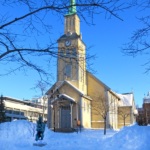






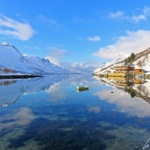


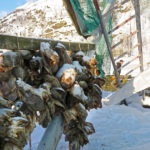


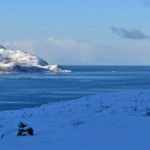





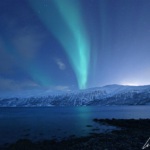


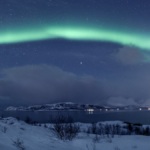


The fjords indeed looks like mirror image and the perfect postcard. Watching the Northern lights on a clear sky is a dream come true and your pictures are drop dead gorgeous. I am little jealous because Aurora Borealis is forever on my bucketlist. Though i’ve been wanting to watch it from Iceland, i’ve never given a thought to watch it from Norway.
Although there are many fjords across the globe, the ones that grace the Norwegian coastline reign as the most popular because of their astonishing beauty 🙂 And aurora borealis, offer an entrancing, dramatic, magical display that fascinates all who see it !!
So beautiful pics!! The Aurora must be so magic…
Seeing the Northern Lights against the dramatic backdrop of Finnish Lapland’s frozen wilderness. For sure, it’s an amazing experience !
Your aurora pictures are gorgeous! I got to see the Northern Lights for the first time in Iceland last year and now I’m dying to travel somewhere new for another chance to see them. Even if there wasn’t so much natural beauty in this area, visiting for a chance to see the lights would be worthwhile in and of itself.
Visiting an arctic destination is already impressive enough but seeing the Northern Lights dance across a star-studded night sky, it’s magic !
I went to Lapland a few months ago and absolutely loved it! I saw the Aurora for like ten seconds (it was pretty cloudy) but still amazing.
Lapland in winter is a magical experience, a scenic winter wonderland blanketed in snow 🙂 I loved it too ! We got totally lucky with the Northern Lights…
This is such a beautiful adventure! I would love to see the Northern Lights one day. What I like about the Tromso area is that you can check out the city and its surroundings during the day and then hunt the auroras at night. The weather was gorgeous when you visited! I am not a fan of cold weather but I will not want to miss the aurora.
The northern lights are nature’s most dazzling light show… it’s often on any traveler’s bucket list. The small town of Tromsø bills itself as Norway’s gateway to the Arctic surrounded by chilly fjords and craggy peaks that remain snow capped for much of the year 🙂
WOW!!! These pictures are incredible. I caught the lights in Iceland but it’s a dream to see them in Lapland.
Lapland is an incredibly beautiful place where nature has been kept unspoiled thanks to the rough conditions 🙂 Should definitely be on your bucket list. And if you get a chance to see Northern Lights on top – one of nature’s most spectacular wonders – it will be even better !
The city is beautiful and the aurora pictures are amazing. How did you feel the first time you saw the aurora? Did you see the aurora more through your naked eyes or your camera lens?
I feel very lucky to have experienced this, and I really look forward to going “hunting” for the aurora again. The first sight of the aurora looked a bit like straws of light popping up from behind the mountain… I was already beaming with satisfaction that I had seen even a small part of this incredible phenomenon, but little did I know it was just getting started … The camera lens is much better than our eyes in that sense, it catches all the color. (not only the color, but the ever-moving shape of the Aurora can be pretty hard… Read more »
The city of Tromsø is absolutely stunning. Had no idea that fjords were deep enough to accommodate ships. Beautiful photography.
Thank you 🙂 Tromsø has a surprising amount to offer and can give you some unique and almost magical experiences. If you are interested in finding out more about the Arctic and northern Norway’s nature and culture, Tromsø is the perfect place !
I am just dying to see the Northern Lights! I’ve read about how cool Tromso is to visit. Perhaps a Lapland trip is in my future for next year…
It’s an amazing experience. Lapland should definitely be on your bucket list. If it’s not, it soon will be… 🙂
Gorgeous aurora pictures. I’m dying to visit Lapland and see them for myself. Love your descriptions of the colors and nature’s movements. Need to get to Lapland sooner than later…!
Lapland is so beautiful itself, that I enjoyed it anyway with or without aurora. But we got totally lucky to observe the Northern Lights 🙂
These are so beautiful. I would love to see the Aurora Borealis but don’t like the cold so much. Tromso or Iceland for the Aurora Borealis is hopefully going to be on the cards for next year.
Great idea ! There might be a chance, that you feel cold in Lapland during winter, especially if you’re not used to air temperatures below zero. If hot is your thing, well, a sauna is the ideal place to toy with the upper limits of what humans can tolerate 😉
Beautiful photos. I will surely add this destination to my bucket list hoping to be lucky enough to see the Aurora Borealis like you and capture some stunning shots 🙂
Seeing the Northern Lights dance across a night sky, it’s an amazing experience ! Lapland should definitely be on your bucket list. If it’s not, it soon will be…
These pics are just beautiful! The text would be easier for me to read if there were more paragraphs =)
Thanks for your advice on paragraphs 🙂 Visiting an arctic destination is already impressive enough but seeing the Northern Lights dance across a star-studded night sky, it’s magic !
Beautiful images and some great information as well. One suggestion: shorter paragraphs to make your text a little easier to read. But the images are amazing!
Thank you for your tip on the text 😉 Lapland is an incredibly beautiful place where nature has been kept unspoiled thanks to the rough conditions !
amazing images
Thank you 🙂
so beautiful pictures u have i love it !
Thank you 🙂 Lapland is as close as reality gets to those who dream of a winter wonderland !